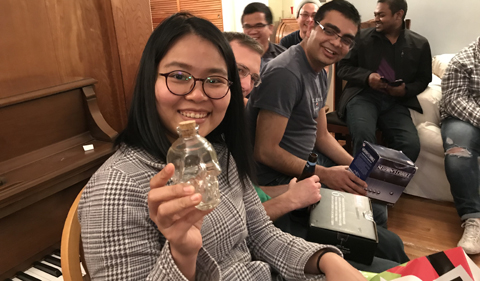Researchers from Ohio University and Chiang Mai University in Thailand are continuing a collaboration that began last year when a Chiang Mai Ph.D. student came to Athens to conduct research with Dr. Katherine Cimatu, Assistant Professor of Chemistry & Biochemistry.
Most recently they collaborated on a journal article on “Successive Surface Reactions on Hydrophilic Silica for Modified Magnetic Nanoparticle Attachment Probed by Sum-Frequency Generation Spectroscopy” in Langmuir.
The authors are: Jeeranan Nonkumwong and Dr. Laongnuan Srisombat of Chiang Mai University in Thailand; Uriel Joseph Erasquin, Kurt Waldo Sy Piecco, Uvinduni I. Premadasan, and Ahmed M. Aboelenen, OHIO graduate students in Chemistry & Biochemistry; Andrew Tangonan; Dr. Jixin Chen, Assistant Professor of Chemistry & Biochemistry at OHIO; Dr. David Ingram, Professor of Physics & Astronomy at OHIO; and Cimatu.
Nonkumwong was a visiting Ph.D. student from the Chemistry Department at Chiang Mai University in Ohio University from March 25, 2017, to March 24, 2018. A research plan titled “Sum Frequency Generation Vibrational Spectroscopy of Lead (II) Adsorbed Ethanolamine Surface Modified Magnesium Ferrite Nanoadsorbents was first developed between her adviser, Srisombat, and Cimatu, her international research supervisor.
Then, Nonkumwong was able to obtain a one-year scholarship using this proposal from the Science Achievement Scholarship of Thailand (SAST) with full financial assistance to support her short term research stay in Ohio University.
She was trained in Cimatu’s laboratory to work in both the wet and laser laboratories to carry the proposed experiments that lead to her co-first authorship the Langmuir publication.
“With the ability to adjust and work in a different environment, Jeeranan along with many colleagues was able to meet her stated research goals. Due to her successful research experience here at Ohio University, we are continuing the international collaboration,” says Cimatu.
Abstract: Successive surface reactions on hydrophilic silica substrates were designed and performed to immobilize ethanolamine-modified magnetic ferrite-based nanoparticle (NP) for surface characterization. The various surfaces were monitored using sum-frequency generation (SFG) spectroscopy. The surface of the hydrophilic quartz substrate was first converted to a vinyl-terminated surface by utilizing a silanization reaction, and then, the surface functional groups were converted to carboxylic-terminated groups via a thiol–ene reaction. The appearance and disappearance of the vinyl (═CH2) peak at ∼2990 cm–1 in the SFG spectra were examined to confirm the success of the silanization and thiol–ene reactions, respectively. Acyl chloride (−COCl) formation from carboxy (−COOH) functional group was then performed for further attachment of magnetic amine-functionalized magnesium ferrite nanoparticles (NPs) via amide bond formation. The scattered NPs attached on the modified silica substrate was then used to study the changes in the spectral profile of the ethanolamine modifier of the NPs for in situ lead(II) (Pb2+) adsorption at the solid–liquid interface using SFG spectroscopy. However, due to the limited number of NPs attached and sensitivity of SFG spectroscopy toward expected change in the modifier spectroscopically, no significant change was observed in the SFG spectrum of the modified silica with magnetic NPs during exposure to Pb2+ solution. Nevertheless, SFG spectroscopy as a surface technique successfully monitored the modifications from a clean fused substrate to −COCl formation that was used to immobilize the decorated magnetic nanoparticles. The method developed in this study can provide a reference for many surface or interfacial studies important for selective attachment of adsorbed organic or inorganic materials or particles.





















Comments